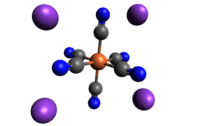亞鐵氰化鉀
| 亞鐵氰化鉀 | |
|---|---|

| |

| |

| |
| IUPAC名 Potassium hexacyanoferrate(II) 六氰合鐵(II)酸鉀 | |
| 別名 | 亞鐵氰化鉀 黃血鹽 |
| 識別 | |
| CAS號 | 13943-58-3(無水) 14459-95-1(三水) |
| PubChem | 161067 |
| ChemSpider | 20162028 |
| SMILES |
|
| EINECS | 237-722-2 |
| 性質 | |
| 化學式 | K4[Fe(CN)6] |
| 摩爾質量 | 三水:422.388 g·mol⁻¹ |
| 外觀 | 淡黃色結晶顆粒 |
| 密度 | 1.85 g/cm3(三水) |
| 熔點 | 70 °C(343 K) |
| 沸點 | 400 °C(673 K) |
| 溶解性(水) | 28.9 g/100 mL(三水,20°C) |
| 溶解性 | 不溶於乙醇、乙醚 |
| 磁化率 | −130.0·10−6 cm3/mol |
| 結構 | |
| 晶體結構 | 單斜 |
| 危險性 | |
GHS危險性符號
| |
| GHS提示詞 | Warning |
| H-術語 | H411 |
| P-術語 | ? |
| NFPA 704 | |
| 閃點 | 不燃 |
| 致死量或濃度: | |
LD50(中位劑量)
|
6400 mg/kg(大鼠口服)[1] |
| 相關物質 | |
| 其他陰離子 | 鐵氰化鉀 |
| 其他陽離子 | 亞鐵氰化鈉 普魯士藍 |
| 附加數據頁 | |
| 結構和屬性 | 折射率、介電係數等 |
| 熱力學數據 | 相變數據、固、液、氣性質 |
| 光譜數據 | UV-Vis、IR、NMR、MS等 |
| 若非註明,所有數據均出自標準狀態(25 ℃,100 kPa)下。 | |
亞鐵氰化鉀,俗稱黃血鹽,化學式為K4[Fe(CN)6]·3H2O,它是配位化合物[Fe(CN)6]4−的鉀鹽。室溫下為檸檬黃色單斜晶體。
合成[編輯]
1752年,法國化學家皮埃爾·約瑟夫·麥克爾首先報道了亞鐵氰化鉀的製備,他通過使普魯士藍與氫氧化鉀反應來實現。[2][3]
現代生產[編輯]
亞鐵氰化鉀在工業上由氰化氫、氯化亞鐵和氫氧化鈣生產,它們組合生成亞鐵氰化鈣Ca2[Fe(CN)6]·11H2O。然後用鉀鹽處理該溶液以沉澱混合的鉀-鈣鹽CaK2[Fe(CN)6],最後再用碳酸鉀處理得到鉀鹽。[4]
歷史生產[編輯]
從歷史上看,該化合物是由含有氮、鐵和碳酸鉀的有機化合物製成的。[5]常見的氮源和碳源是焙燒後的角、皮革廢料、內臟或干血。它也可以從煤氣廠的廢氧化物(含有氰化氫)中獲得。
化學性質[編輯]
用硝酸處理亞鐵氰化鉀可以得到H2[Fe(NO)(CN)5]。用碳酸鈉中和後,可以選擇性地結晶出硝普鈉的紅色晶體。[6]
- 2 K4[Fe(CN)6] + Cl2 → 2 K3[Fe(CN)6] + 2 KCl
該反應可用於從溶液中去除亞鐵氰化鉀。[來源請求]
亞鐵氰化鉀和鐵鹽反應生成普魯士藍Fe3+
4[Fe2+
CN)
6]
3,這種物質是藍圖顏色的來源。
應用[編輯]
亞鐵氰化鉀在工業中有許多應用。它和其鈉鹽被廣泛用作路鹽和食鹽的抗結劑。亞鐵氰化鉀和亞鐵氰化鈉也被用於錫的提純和從鉬礦石中分離銅。亞鐵氰化鉀可用於生產葡萄酒和檸檬酸。[4]
截至2017年,在歐盟,亞鐵氰酸鹽(E535–538)僅被授權在兩個食品類別中作為鹽替代品。腎是亞鐵氰酸鹽毒性的器官。[7]
亞鐵氰化鉀可用於動物飼料。[8]
在實驗室中,亞鐵氰化鉀用於確定高錳酸鉀的濃度,這種化合物通常用於氧化還原滴定。 亞鐵氰化鉀與鐵氰化鉀和磷酸鹽緩衝溶液混合使用,為β-半乳糖苷酶提供緩衝液,該酶用於裂解X-gal,使與β-gal共軛的抗體(或其他分子)與目標結合的地方呈現出明亮的藍色。 在與鐵離子反應時,它會產生普魯士藍色。因此,它被用作實驗室中鐵的鑑定試劑。
亞鐵氰化鉀可用作植物的肥料。[來源請求]
公元1900年前,在卡斯納法發明之前,亞鐵氰化鉀是鹼金屬氰化物的最重要來源。[4]在這個歷史過程中,氰化鉀是通過分解亞鐵氰化鉀產生的[5]:
- K4[Fe(CN)6] → 4 KCN + FeC2 + N2
其中,FeC2是計量比組成的混合物,包括α-Fe、C和Fe3C等。[9]若在空氣中熱分解,則會有KFeO2等氧化產物。[10]
結構[編輯]
與其他金屬氰化物一樣,亞鐵氰化鉀不管是水合物還是無水鹽,都具有複雜的聚合結構。該聚合物由八面體 [Fe(CN)6]4−中心與CN配體結合的K+離子交聯。[11]當固體溶解在水中時,K-CN鍵會斷裂。[來源請求]
毒性[編輯]
亞鐵氰化鉀無毒,在體內不會分解為氰化物。對大鼠的毒性低,致死量 (LD50) 為6400mg/kg。[12]
參見[編輯]
參考資料[編輯]
- ^ http://chem.sis.nlm.nih.gov/chemidplus/rn/13943-58-3
- ^ Macquer. Éxamen chymique de bleu de Prusse [Chemical examination of Prussian blue]. Histoire de l'Académie royale des sciences … , § Mémoires de l'Académie royale des Sciences. 1752: 60–77 [2022-01-29]. (原始內容存檔於2022-01-29) (法語). From pp. 63-64: "Après avoir essayé ainsi inutilement de décomposer le bleu de Prusse par les acides, … n'avoit plus qu'une couleur jaune un peu rousse." (After having tried so vainly to decompose Prussian blue by acids, I made recourse to alkalies. I put a half ounce of this [Prussian] blue in a flask, and I poured on it ten ounces of a solution of nitre fixed by tartar [i.e., potassium nitrate (nitre) which is mixed with crude cream of tartar and then ignited, producing potassium carbonate]. As soon as these two substances had been mixed together, I saw with astonishment that, without the aid of heat, the blue color had entirely disappeared; the powder [i.e., precipitate] at the bottom of the flask had only a rather gray color: having put this vessel on a sand bath in order to heat the solution until it simmered, this gray color also disappeared entirely, and all that was contained in the flask, both the powder [i.e., precipitate] and the solution, had only a yellow color [that was] a little red.)
- ^ Munroe, Charles E.; Chatard, Thomas M. Manufactures: Chemicals and Allied Products. Twelfth Census of the United States: Bulletins. 1902, (210): 1–306 [2022-01-29]. (原始內容存檔於2022-01-29).; see p. 31.
- ^ 4.0 4.1 4.2 Gail, E.; Gos, S.; Kulzer, R.; Lorösch, J.; Rubo, A.; Sauer, M.; Kellens, R.; Reddy, J.; Steier, N.; Hasenpusch, W. Cyano Compounds, Inorganic. Ullmann's Encyclopedia of Industrial Chemistry. Weinheim: Wiley-VCH. October 2011. ISBN 978-3527306732. doi:10.1002/14356007.a08_159.pub3.
- ^ 5.0 5.1 Von Wagner, Rudolf. Manual of chemical technology. New York: D. Appleton & Co. 1897: 474 & 477 [2022-03-13]. (原始內容存檔於2019-03-09).
- ^ Seel, F. Sodium nitrosyl cyanoferrate. Brauer, G. (編). Handbook of Preparative Inorganic Chemistry 2 2nd. New York: Academic Press: 1768. 1965 [2022-01-29]. LCCN 63-14307. (原始內容存檔於2010-03-07).
- ^ Peter Aggett, Fernando Aguilar, Riccardo Crebelli, Birgit Dusemund, Metka Filipič, Maria Jose Frutos, Pierre Galtier, David Gott, Ursula Gundert‐Remy, Gunter Georg Kuhnle, Claude Lambré, Jean‐Charles Leblanc, Inger Therese Lillegaard, Peter Moldeus, Alicja Mortensen, Agneta Oskarsson, Ivan Stankovic, Ine Waalkens‐Berendsen, Rudolf Antonius Woutersen, Matthew Wright and Maged Younes. Re‐evaluation of sodium ferrocyanide (E 535), potassium ferrocyanide (E 536) and calcium ferrocyanide (E 538) as food additives. EFSA Journal. 2018, 16 (7): 5374 [2022-01-29]. PMC 7009536
 . PMID 32626000. doi:10.2903/j.efsa.2018.5374
. PMID 32626000. doi:10.2903/j.efsa.2018.5374  . (原始內容存檔於2022-01-29).
. (原始內容存檔於2022-01-29).
- ^ EuSalt Expert Meeting on E 535 and E 536 as Feed Additives. EUSalt. [2022-01-29]. (原始內容存檔於2019-05-12).
- ^ Ormont, B.; Petrov, B. A. Thermal decomposition of simple and complex cyanides with formation of alkali metals, especially potassium. Monatshefte fuer Chemie. 1936, 68: 171-187. ISSN 0026-9247.
- ^ J. I. Kunrath, C. S. Müller, E. Frank. Thermal decomposition of potassium hexacyanoferrate(II) trihydrate. Journal of Thermal Analysis. 1978-12, 14 (3): 253–264 [2023-02-12]. ISSN 0022-5215. doi:10.1007/BF01915163 (英語).
- ^ Willans, M.J.; Wasylishen, R.E.; McDonald, R. "Polymorphism of potassium ferrocyanide trihydrate as studied by solid-state multinuclear NMR spectroscopy and X-ray diffraction" Inorganic Chemistry 2009, volume 48, p4342-4353
- ^ POTASSIUM FERROCYANIDE MSDS Number: P5763 - Effective Date: 12/08/96. J. T. Baker Inc. [2012-04-08]. (原始內容存檔於2015-11-21).
外部連結[編輯]
- Cyanide (inorganic) compounds fact sheet. National Pollutant Inventory Australia. [2022-01-29]. (原始內容存檔於2013-04-09).
| |||||||||||||||||||||||||||||||||||||

